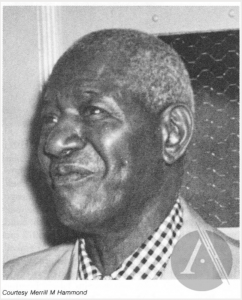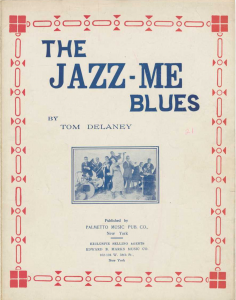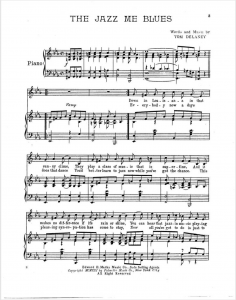Sheet music is always super exciting. Well, maybe not always. But, that statement probably would have fit popular sentiment in the late 19th and early 20th century as evidenced by all Tin Pan Alley composers, lyrists, and producers who churned an exorbitant amount of music. Looking through the Sheet Music Consortium, one such piece caught my eye because it not only seemed connected to our class discussions on Tin Pan Alley, but also our classes on Jazz and the Blues.

Tom Delaney (1889-1963). Jazz and blues composer.
“The Jazz-Me Blues” were published by Palmetto Music Publishing Company in New York in 1921, and were written by Tom Delaney, who surprisingly, seems to be a bit of an enigma in my academic research sources.1 What I did find was that he lived from 1889 to 1963, was an African American composer, and he wrote a lot of jazz and blues songs that were popular in the 20’s and later.2 “The Jazz-Me Blues” are one of his songs for which there are many later recordings, a lot of them include a full band and exclude the vocal line.3 Maybe this is the way that Delaney meant for the piece to eventually be performed, as the cover of the music pictures what appears to be an all-black jazz band, and the piano arrangement was just for individual household consumption.

The cover of “The Jazz-Me Blues” by Tom Delaney, published in 1921.
Something else that is interesting about the cover is that it differs from the sheet music covers we looked at and talked about in class. Most of those depicted fictional scenes or characters, a famous singer or performer, or racial caricatures if depicting black people. Perhaps this is a notable band, and separated from the time, we don’t know that. But what is important is that the fame of the band is not what is being used to sell the music unlike the ones in class. It also is worth noting that this is a positive portrayal of black Americans; not a caricature. Is that only because right above are the words “Jazz” and “Blues”, which were connected to blackness? Or, was this music written for a different audience and purpose than what we looked at in class?
Turning the page to look at the actual provides other examples of the coupling of certain music and race, albeit in a perhaps more covert manner. The melody relies on syncopation, even mentioning the word “syncopation” in conjunction with what jazz is. This is one of the sonic markers of blackness that we spoke about in class. Additionally, the lyrics talk about jazz and “jazz-time”, as well as “ragtime” and, of course, “blues”. Again, these are all musical genres that at the time were considered black.
Another interesting portrait is painted by the lyrics:
Down in Louisiana in that sunny clime,
They play a class of music that is super-fine,
And it makes no difference if it’s rain or shine,
You can hear that jazz-in music playing all the time.
It is almost as if the people in Louisiana do nothing but sing, dance, and play jazz. Yet, this also can be read in conjunction with the last line: “I’ve got those dog-gone low-down jazz me, jazz me blues”, implying that life is really is great as long as you have jazz, which seems to thus celebrate jazz.

The first page of sheet music for “The Jazz-Me Blues“.
Ultimately, in thinking about how Rydell argued that sheet music was responsible for normalizing public attitudes, I wonder about what message this song spread.4 I’m not sure. On the one hand, it seems to reinforce a lot of the musical black stereotyping we have talked about in class. Yet, on the other hand, it does come across a celebration of jazz, and, according to some sources, it was this composition, among others, that helped Delaney get out of poverty. Perhaps, like much of life, the answers are not as clear as they may at first appear.
1 Delaney, Tom. “Jazz me blues”. New York: Palmetto Music Co., 1921. Retrieved from: http://webapp1.dlib.indiana.edu/metsnav/inharmony/navigate.do?oid=http://fedora.dlib.indiana.edu/fedora/get/iudl:338252/METADATA&pn=3&size=screen.
2 The Commodore Master Takes. Recorded February 28, 2006. Universal Classics & Jazz, 2006, Streaming Audio. https://search.alexanderstreet.com/view/work/bibliographic_entity%7Crecorded_cd%7C695030. (Delaney birth and death dates)
Harris, Sheldon. “Thomas Henry ‘Tom’ Delaney.” In Thomas Henry ‘Tom’ Delaney, 877. New Rochelle, NY: Da Capo Press, 1994. https://search.alexanderstreet.com/view/work/bibliographic_entity%7Creference_article%7C1004410925.
3 Search for “Tom Delaney” and “Jazz-Me Blues” in Alexander Street. https://search.alexanderstreet.com/jazz/search?searchstring=tom%20delaney&is_lti_search=&term%5B0%5D=jazz%20me%20blues.
4 Robert W. Rydell, “Soundtracks of Empire: ‘The White Man’s Burden,’ the War in the Philippines, the ‘Ideals of America,’ and Tin Pan Alley”, European journal of American studies [Online], 7-2 (2012). Accessed on March 22 2018. DOI : 10.4000/ejas.9712.

